Abstract
Modifying the electronic structure of a catalyst through interface engineering is an effective strategy to enhance its activity in the hydrogen evolution reaction (HER). Interface engineering is a viable strategy to enhance the catalytic activity of transition metal phosphides (TMPs) in the HER process. The interface-engineered FeP/NiP2/Ni5P4/NiP multi-metallic phosphide nanoparticles confined in a N, P-doped carbon matrix was developed by a simple one-step low-temperature phosphorization treatment, which only requires 72 and 155 mV to receive the current density of 10 mA/cm2 in acid and alkaline electrolyte, respectively. This enhanced performance can be primarily attributed to the heterointerface of FeP/NiP2/Ni5P4/NiP multi-metallic phosphides, which promotes electron redistribution and optimizes the adsorption/desorption strength of H* on the active sites. Furthermore, the N, P-doped carbon framework that encapsulates the nanoparticles inhibits their aggregation, leading to an increased availability of active sites throughout the reaction. The results of this study open up a straightforward and innovative approach to developing high-performance catalysts for hydrogen production.
1. Introduction
Hydrogen is regarded as an eco-friendly, clean energy source that holds promise in addressing environmental challenges and the global energy deficit [1,2]. Among the various hydrogen production methods, electrochemical water splitting is a leading strategy [3]. Traditionally, Pt-based materials have been hailed as top-tier electrocatalysts. Historically, Pt-based materials have been recognized as premium electrocatalysts; nevertheless, their elevated cost and restricted accessibility impede broad adoption. Consequently, attention has turned towards earth-abundant elements that offer cost-effectiveness and high performance in hydrogen production [4,5].
Transition metal phosphides are gaining recognition as promising materials owing to their high conductivity and cost-effectiveness [6]. FeP shows particular promise as a hydrogen evolution reaction (HER) catalyst [7]. Despite considerable efforts to synthesize high-performance TMPs for hydrogen production, their HER activity remains unsatisfactory [8,9]. To address this, coordinating multiple metal phosphides in the catalytic structure can offer increased active sites and electronic structure regulation through interface interactions to adjust the H* adsorption energy of the active sites. Therefore, the modulation of the electronic structure through interface engineering is a kind of direct and optimal route to enhance its HER activity. For instance, MoO2-FeP demonstrates improved HER performance attributed to changes in the interfacial electronic structure via heterojunction formation, leading to an enhanced number of active sites [10].
Creating bimetallic and multi-metallic phosphides is an effective approach for establishing interfaces in hydrogen production [11]. However, the aggregation of nanoparticles during annealing or hydrogen production poses a challenge in forming multi-metallic phosphides. To mitigate this issue, a carbon matrix can serve dual purposes: preventing nanoparticle aggregation and enhancing catalyst conductivity [12]. Nevertheless, the intrinsic activity of carbon is relatively low, which can negatively impact the hydrogen evolution reaction (HER) performance of carbon-encapsulated catalysts [13]. Recent findings indicate that N doping in carbon materials can significantly boost HER performance by increasing the exposure of active sites during the reaction [14,15].
Metal–organic frameworks (MOFs) containing organic ligands find extensive use in producing N-doped carbon materials to expose more active sites. They also serve as conducting substrates that accelerate electron transfer in catalysts [16,17]. Additionally, the N-doped carbon matrix offers protection to transition metal phosphide (TMP) nanoparticles, preventing aggregation during reactions [18,19]. However, it is noteworthy that while the MOF-templated method has been predominantly used for producing monometallic or bimetallic phosphides, reports on facile synthesis methods for multi-metallic phosphides are scarce [20,21].
In this study, we introduce a simple one-step phosphating technique for synthesizing N, P-doped carbon-matrix-encapsulated multi-metallic phosphide FeP/NiP2/Ni5P4/NiP nanoparticles (FeP/NiP2/Ni5P4/NiP@NPC). The Fe/Ni-MOF precursor was prepared through simple stirring without requiring a hydrothermal reaction. This design capitalizes on the collaborative advantages of FeP/NiP2/Ni5P4/NiP, which offer abundant heterointerfaces that provide more active sites, and the N, P-doped carbon matrix, which shields FeP/NiP2/Ni5P4/NiP nanoparticles from aggregation. As a result, the prepared catalyst demonstrates outstanding hydrogen evolution reaction (HER) performance, showcasing overpotentials of 71.8 and 155.0 mV in acid and alkaline electrolytes, respectively. With its impressive performance in both acid and alkaline environments, FeP/NiP2/Ni5P4/NiP@NPC shows promise for practical applications.
2. Materials and Methods
2.1. Sample Preparation
2.1.1. N, P-Doped Carbon-Shell-Encapsulated FeP/NiP2/Ni5P4/NiP Nanoparticles
First, 2 mmol FeCl3 and 3 mmol NiCl2 were dissolved in 50 mL DI water, and after stirring for 20 min, this solution was labeled as solution A. Then, 10 mmol 2-methylimidazole was added to the solution mentioned above and, after stirring for 30 min, the precursor was left to stand for 24 h. Following this, the obtained precursor was centrifuged and washed with DI water and ethanol 3 times. After careful washing, the prepared precursor was dried in a vacuum oven at 60 °C for 24 h. The obtained powder was ground carefully, and this fine powder was labeled as precursor B. The obtained fine powder was annealed in an Ar atmosphere with NaH2PO2 placed upstream of the crucible at 450 °C for 2 h, and labeled as FeP/NiP2/Ni5P4/NiP@NPC.
2.1.2. N, P-Doped Carbon-Shell-Encapsulated FeP Nanoparticles
The precursor was annealed under the same conditions as FeP/NiP2/Ni5P4/NiP@NPC, but without the addition of NiCl2 into solution A; the prepared sample was labeled as FeP@NPC.
2.1.3. N-Doped Carbon-Shell-Encapsulated Fe2O3/NiO Nanoparticles
Precursor B was annealed at 450 °C for 2 h in an Ar atmosphere without NaH2PO2 placed upstream of the crucible; the prepared sample was named Fe2O3/NiO@NPC.
2.2. Material Characterization
The Rigaku Corporation Smart lab was used to perform the powder X-ray diffraction (XRD) patterns; the scan angle ranged from 20° to 80°, with a scan rate of 2°/min and a wavelength of 0.15406 nm to examine the crystal structure of the prepared catalysts. The surface morphology of the prepared catalysts was obtained through scanning electron microscopy (FEI XL30 S-FEG), transmission electron microscopy (TEM), and high-resolution transmission electron microscopy (HRTEM). The elemental composition and surface electronic state of the samples was analyzed by X-ray photoelectron spectroscopy (XPS).
2.3. Electrochemical Measurements
All electrochemical measurements were assessed through a three-electrode system on the CHI 650E electrochemical workstation. The Pt sheet was applied as the counter electrode and the Ag/AgCl electrode was applied as the reference electrode. The working electrodes were prepared as follows: 5 mg of the prepared catalyst was added to 250 µL ethanol and 50 µL Nafion 117 solution (5 wt%) after ultrasonication for 5 min; then, 1.5 mg carbon black was added to the slurry mentioned above, and after 15 min of ultrasonication in an ice water bath, the prepared slurry was dropped on the glassy carbon electrode and left in the air to dry. All of the potentials reported in this article were converted using the Nernst equation: E(RHE) = E(Ag/AgCl) + 0.059 pH + 0.198 V. The linear sweep voltammetry (LSV) was obtained through the scan rate of 5 mV s−1, and the electrochemical impedance spectroscopy (EIS) was characterized under the voltage of 83 mV and 158 mV in acid and alkaline electrolytes, respectively. The electrochemical active surface area (ECSA) was analyzed through the electrochemical double-layer capacitance (Cdl), and the cyclic voltammetry (CV) was characterized under different scan rates from 20 mV s−1 to 100 mV s−1. The stability test was applied through the comparison of LSV curves before and after 1000 CV cycles, as well as the chronopotentiometry test under the overpotential of 75 and 155 mV in the acid and alkaline electrolytes.
3. Results
The FeP/NiP2/Ni5P4/NiP@NPC composites were synthesized following the procedure outlined in Scheme 1. Firstly, the FeCl3 and NiCl2 were dissolved in the DI water to make a uniform solution. After that, 2-methylimidazole was added to the solution where Fe ions and Ni ions were coordinated with the organic linker of 2-methylimidazole (Fe/Ni-MOF). Finally, the FeP/NiP2/Ni5P4/NiP@NPC nanoparticles encapsulated by the N, P-doped carbon matrix were formed through subsequent annealing and phosphating with NaH2PO2.
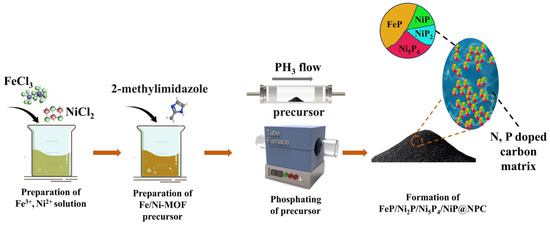
Scheme 1.
Schematic illustration of the preparation process for FeP/NiP2/Ni5P4/NiP@NPC.
The X-ray diffraction (XRD) spectrum depicted in Figure 1 was used to examine the crystal structures of FeP/NiP2/Ni5P4/NiP@NPC, FeP@NPC, and Fe2O3/NiO@NPC. The crystal structures of Fe2O3/NiO@NPC indicate the formation of NiFe2O4 (#10-0325) [22], while the crystal structure of FeP@NPC is mainly FeP (#71-2262) [23]. In addition, for the FeP/NiP2/Ni5P4/NiP heterostructure, the diffraction peaks at 32.74°, 34.51°, 37.15°, and 46.29° can be ascribed to the diffraction of (011), (200), (111), and (121) of FeP (#71-2262), while peaks at 28.21°, 36.69°, 40.35°, 46.94°, and 61.03° indexed to the (111), (210), (211), (220), and (230) peaks of NiP2 (#21-0590) [24]. Furthermore, the peaks located at 22.15°, 31.47°, 41.42°, 45.14°, 51.91°, 53.98°, and 56.36° demonstrate the formation of (102), (201), (211), (204), (205), (220), and (310) peaks of Ni5P4 [25] (shown in Figures S1–S3). The above XRD patterns indicate the successful preparation of various multi-metallic phosphide phases using the single-step phosphating method.
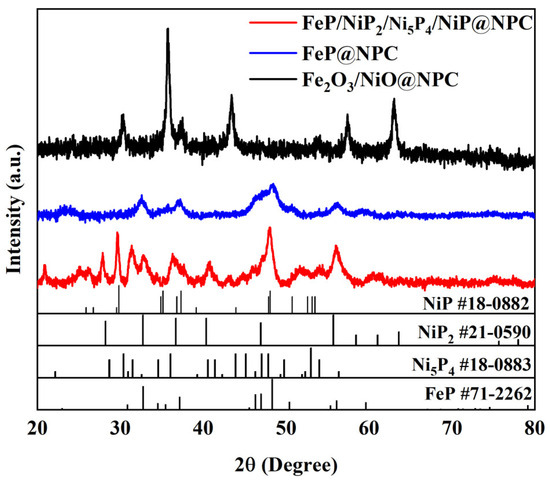
Figure 1.
The XRD patterns of FeP/NiP2/Ni5P4/NiP@NPC; FeP@NPC; Fe2O3/NiO@NPC.
The morphology of FeP/NiP2/Ni5P4/NiP@NPC, FeP@NPC, and Fe2O3/NiO@NPC were characterized, and the corresponding SEM images are depicted in Figure 2 and Figure S4. The morphologies of the prepared catalysts do not exhibit significant differences, and the formation of large particles can be attributed to the annealing process. Energy-dispersive X-ray spectroscopy (EDS) analysis (Figure 2d–i) revealed that FeP/NiP2/Ni5P4/NiP@NPC aggregated together during the annealing process, and Fe, Ni, P, N, C, and O elements were distributed uniformly throughout the catalyst. The analysis confirms the homogeneous dispersion of multi-metallic phosphide phases (FeP/NiP2/Ni5P4/NiP) within the N, P-doped carbon matrix.
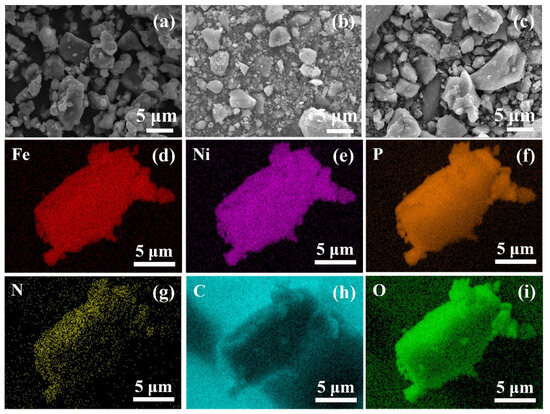
Figure 2.
SEM images of the sample of (a) FeP/NiP2/Ni5P4/NiP@NPC, (b) FeP@NPC, and (c) Fe2O3/NiO@NPC; (d–i) elemental mapping images of FeP/NiP2/Ni5P4/NiP@NPC.
Transmission electron microscopy (TEM) images were collected to further analyze the morphology of FeP/NiP2/Ni5P4/NiP@NPC. Despite the formation of large bulks around 15 μm due to the annealing process, as shown in the SEM images, much smaller nanoparticles are embedded within these large bulks and they are well separated without aggregation (Figure 3a–c). Detailed structural information of FeP/NiP2/Ni5P4/NiP@NPC was analyzed, with the interfacial boundary of FeP/NiP2/Ni5P4/NiP demonstrated by the HR-TEM images. As exhibited in Figure 3d, the interplanar crystal spacing of 0.27 nm corresponds to the (011) plane of FeP, the spacing of 0.17 nm aligns with the (220) plane of Ni5P4, and lattice fringes of 0.22 nm indicate the (111) phase of NiP2, respectively. This intimate boundary of FeP/NiP2/Ni5P4/NiP generates a heterointerface, and the strong electron interaction effect of this heterointerface could provide more activity and enhance the conductivity of the catalyst during hydrogen production. The energy-dispersive spectroscopy (EDS) mappings in Figure S5 illustrate that the elements of Fe, Ni, N, P, C, and O are uniformly distributed in the catalysts, indicating that FeP/NiP2/Ni5P4/NiP nanoparticles are uniformly confined within the N, P-doped carbon matrix.
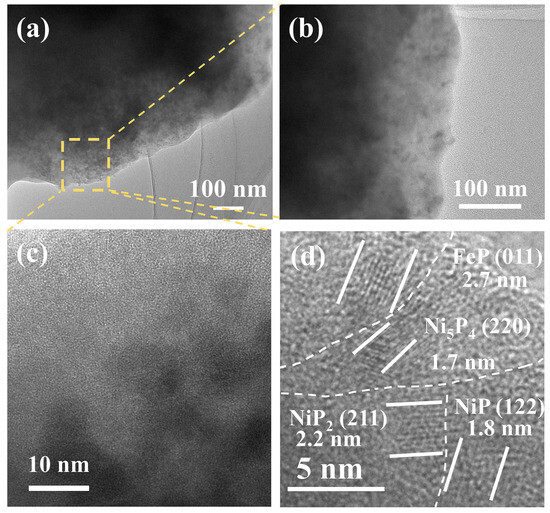
Figure 3.
(a–c) TEM images and (d) HR-TEM images of FeP/NiP2/Ni5P4/NiP@NPC nanocomposites.
An X-ray photoelectron spectroscopy (XPS) analysis was conducted to investigate the chemical compositions of FeP/NiP2/Ni5P4/NiP@NPC and FeP@NPC. In Figure 4a, the high-resolution XPS spectrum of Fe 2p for FeP/NiP2/Ni5P4/NiP@NPC reveals two peaks at 705.32 and 717.13 eV, attributed to the existence of Fe-P bonds. The main peaks located at 708.90 and 712.09 eV correspond to Fe3+ and Fe2+ of Fe 2p3/2, while the peaks at 722.86 and 727.55 eV are associated with Fe3+ and Fe2+ of Fe 2p1/2, indicating the presence of Fe-O bonds due to surface oxidation [18]. The Ni 2p spectra of FeP/NiP2/Ni5P4/NiP@NPC (Figure 4b) can be deconvoluted into five components: a pair of peaks appeared at 852.03/863.29 eV, reflecting Ni 2p3/2 and Ni 2p3/2 related to Ni species in Ni-P. A pair of peaks located at 860.05 and 877.51 eV are attributed to the satellite peaks belonging to the surface oxidation of the catalysts in the air [26]. As shown in Figure 4c, the peaks with the binding energy of 127.89 and 128.50 eV appeared in the spectrum of P 2p, corresponding to the metal-P bonds, and the peak at 132.37 eV was assigned to the formation of P-C bonding. The N 1s region (Figure 4d) reveals peaks at 401.54, 398.34, and 399.94 eV, representing pyridinic N, Pyrrolic N, and graphitic N in the N, P-doped carbon matrix [27]. Significantly, the Fe 2p peaks of FeP/NiP2/Ni5P4/NiP@NPC are negatively shifted approximately 1.6 eV to the lower binding energy compared to FeP@NPC, and the shift of binding energy indicating that electrons transfer to Fe atoms. Furthermore, compared to FeP@NPC, FeP/NiP2/Ni5P4/NiP@NPC also shows a negative shift, indicating electron transfer from Ni to Fe and P, highlighting the strong interaction at the heterointerface among FeP, NiP2, and Ni5P4 [26].
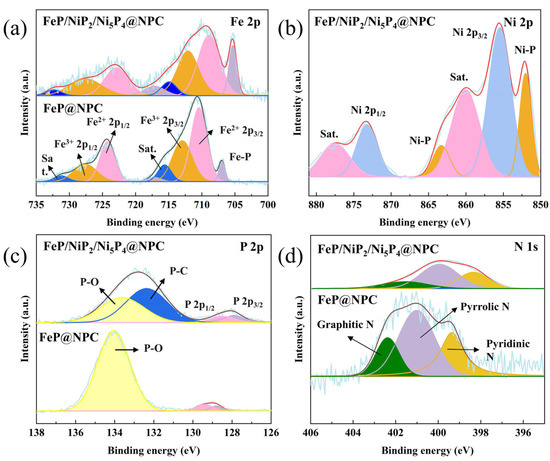
Figure 4.
XPS spectra of FeP/NiP2/Ni5P4/NiP@NPC and FeP@NPC: (a) Fe 2p, (b) Ni 2p, (c) P 2p, (d) N 1s.
The prepared catalysts were directly characterized as the working electrode to investigate the HER performance through a three-electrode configuration in both acid and alkaline electrolytes. The hydrogen production activity of FeP/NiP2/Ni5P4/NiP@NPC was examined by the LSV curves, as depicted in Figure 5a, alongside FeP@NPC, Fe2O3/NiO@NPC, and Pt for comparison. All potentials in the LSV curve were subjected to iR correction to correct for measured potentials due to solution resistance. Pt exhibited the lowest LSV overpotential, while Fe2O3/NiO@NPC showed poor HER activity. FeP@NPC demonstrated enhanced HER performance, with an overpotential of 144 mV at a current density of 10 mA/cm2, highlighting the significant role of FeP in hydrogen production. Following the formation of FeP/NiP2/Ni5P4/NiP multi-metallic phosphide nanoparticles, the HER performance of FeP/NiP2/Ni5P4/NiP@NPC significantly improved, with an overpotential of 72 mV at a current density of 10 mA/cm2. The enhanced HER activity of the catalysts could be attributed to the electron redistribution among different phases due to the electron transfer caused by the electronegativity of different elements. The electron redistribution changes the electronic structure and the d-band center of the catalyst; thus, the H* intermediate adsorption and desorption during hydrogen production can be optimized, therefore enhancing the HER activity [28,29,30,31]. The result emphasizes the importance of multi-metallic phosphide formation. The Tafel slope was employed to assess the HER kinetics, as shown in Figure 5b. The FeP/NiP2/Ni5P4/NiP@NPC could provide a Tafel slope as low as 96.6 mV dec−1, smaller than those of comparative samples FeP@NPC (111.7 mV dec−1) and Fe2O3/NiO@NPC (135.1 mV dec−1). The smallest Tafel slope indicates that FeP/NiP2/Ni5P4/NiP@NPC exhibits the most favorable and faster reaction kinetics during hydrogen production compared to other catalysts [32] (Table S1).
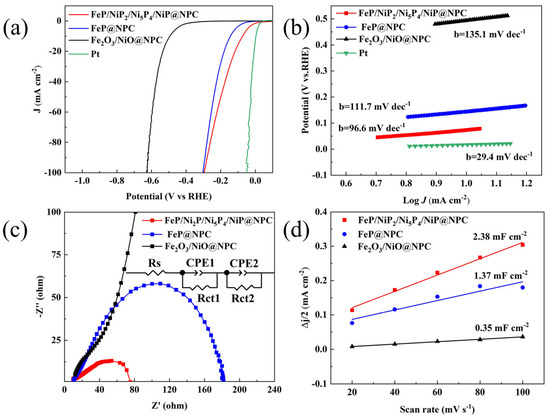
Figure 5.
(a) LSV curve; (b) Tafel slope of FeP/NiP2/Ni5P4/NiP@NPC, FeP@NPC, Fe2O3/NiO@NPC, and Pt; (c) Nyquist plot; and (d) capacitive current difference versus scan rate of FeP/NiP2/Ni5P4/NiP@NPC, FeP@NPC, and Fe2O3/NiO@NPC in 0.5 M H2SO4.
The electrochemical impedance spectroscopy (EIS) was further investigated to explore the HER kinetics in the catalysis process, as shown in Figure 5c. EIS analysis allows for the examination of electron transfer at the catalyst–interface interface [33]; the low charge transfer resistance (Rct) of FeP/NiP2/Ni5P4/NiP@NPC (74.6 Ω cm−2) can be attributed to the formation of FeP/NiP2/Ni5P4/NiP multi-metallic phosphide, which regulates the electronic structure through interface interactions, thereby reducing the electron transfer resistance of the catalysts. The electrochemically active surface area was also utilized to delve deeper into the HER kinetics. The cyclic voltammetry (CV) curves in the non-Faradaic region were acquired to analyze the value of double-layer capacitance (Cdl) shown in Figure 5d and Figure S6 [34]. The Cdl of FeP/NiP2/Ni5P4/NiP@NPC is 2.38 mF cm−2, which is higher than that of FeP@NPC (1.37 mF cm−2) and Fe2O3/NiO@NPC (0.35 mF cm−2). This improvement in HER performance can be attributed to FeP/NiP2/Ni5P4/NiP multi-metallic phosphide, which provides more active sites and leads to the unique structure of N, P-doped carbon matrix encapsulation, protecting nanoparticles from aggregation and, thus, exposing more active sites.
The lower efficiency of water dissociation in alkaline electrolytes results in reduced hydrogen evolution reaction (HER) activity compared to acidic electrolytes. As depicted in Figure 6a, FeP/NiP2/Ni5P4/NiP@NPC exhibits exceptional HER performance with a low overpotential of 155 mV, which is much lower than that of FeP@NPC (188.1 mV) and Fe2O3/NiO@NPC (527.1 mV). The Tafel slope curves (Figure 6b) demonstrate that FeP/NiP2/Ni5P4/NiP@NPC presents the highest HER kinetics among FeP@NPC (82 mV dec−1) Fe2O3/NiO@NPC (115 mV dec−1). The smallest Rct of FeP/NiP2/Ni5P4/NiP@NPC (Figure 6c) further confirms its superior electron transfer efficiency owing to the multi-metallic phosphide structure. Additionally, FeP/NiP2/Ni5P4/NiP@NPC (5.04 mF cm−2) exhibits the largest active sites during hydrogen production compared to FeP@NPC (1.13 mF cm−2) and Fe2O3/NiO@NPC (0.68 mF cm−2), as shown in Figure 6d and Figure S7. These results highlight the conductivity enhancement and active site exposure facilitated by multi-metallic phosphides. Moreover, the N, P-doped carbon matrix protects FeP/NiP2/Ni5P4/NiP nanoparticles from aggregation, increasing active site exposure during hydrogen production.
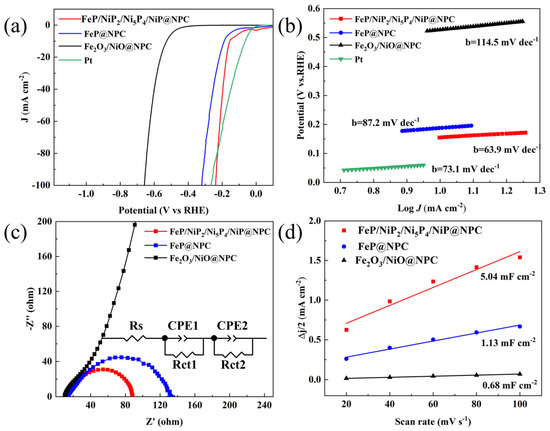
Figure 6.
(a) LSV curve; (b) Tafel slope of FeP/NiP2/Ni5P4/NiP@NPC, FeP@NPC, Fe2O3/NiO@NPC, and Pt; (c) Nyquist plot; and (d) capacitive current difference versus scan rate of FeP/NiP2/Ni5P4/NiP@NPC, FeP@NPC, and Fe2O3/NiO@NPC in 1.0 M KOH.
The stability of the catalysts was evaluated by collecting linear sweep voltammetry (LSV) curves before and after a 1000-cycle cyclic voltammetry (CV) test. The polarization curves displayed negligible current density loss after the 1000-cycle CV test, indicating excellent stability, as shown in Figure 7a. The prolonged durability and stability of FeP/NiP2/Ni5P4/NiP@NPC during hydrogen production were further assessed through chronopotentiometry tests under voltages of 72 mV and 155 mV in acid and alkaline, respectively (Figure 7b). It can be observed that the potential has nonobvious decay over the long-term continuous test, which demonstrates the outstanding stability and durability of FeP/NiP2/Ni5P4/NiP@NPC. Additionally, SEM and TEM images were collected after the long-term stability test. The morphology of FeP/NiP2/Ni5P4/NiP@NPC showed no signs of aggregation, as shown in Figures S8 and S9, confirming the stable structure of the N, P-doped carbon FeP/NiP2/Ni5P4/NiP nanoparticles.
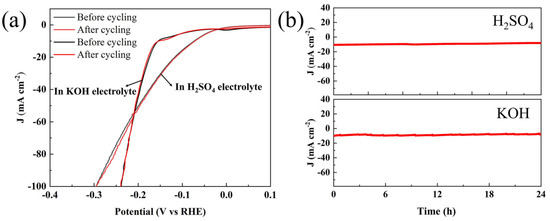
Figure 7.
(a) Stability of FeP/NiP2/Ni5P4/NiP@NPC before and after 1000 cycles in acid and alkaline electrolytes; (b) chronoamperometric curve of FeP/NiP2/Ni5P4/NiP@NPC at 72 mV in acid electrolyte, and chronoamperometric curve of FeP/NiP2/Ni5P4/NiP@NPC at 155 mV in alkaline electrolyte.
4. Conclusions
In summary, we present a straightforward method for the interface engineering of FeP/NiP2/Ni5P4/NiP multi-metallic phosphide nanoparticles embedded in an N, P-doped carbon matrix, demonstrating their high efficiency as catalysts for the hydrogen evolution reaction (HER) in both acidic and alkaline electrolytes. Leveraging the unique N, P-doped carbon matrix and innovative FeP/NiP2/Ni5P4/NiP multi-metallic phosphide heterointerface, the electrode boasts a large number of active sites and facilitates electron redistribution, thereby optimizing the absorption/desorption strength of H* on these active sites. The experimental results demonstrate that FeP/NiP2/Ni5P4/NiP@NPC exhibits enhanced HER activity with the overpotential of 72 and 155 mV to receive the current density of 100 mA cm−2 in acid and alkaline electrolytes. It maintains long-term stability over 24 h in 0.5 M H2SO4 and 1.0 M KOH. Our work presents a simple approach to synthesizing N, P-doped carbon-encapsulated multi-metallic phosphide heterointerface catalysts for hydrogen production, advancing the development of high-performance hydrogen evolution reaction (HER) catalysts and contributing to the field of green energy conversion.
Supplementary Materials
The following supporting information can be downloaded at: https://www.mdpi.com/article/10.3390/coatings14070817/s1. References [35,36,37,38,39] are cited in the supplementary materials.
Author Contributions
T.Z.: methodology, investigation, data curation, writing—original draft. J.Z.: formal analysis. W.G.: writing—review and editing. Y.W.: supervision, writing—review and editing. All authors have read and agreed to the published version of the manuscript.
Funding
Ting Zhang was supported by the Jiangsu Postdoctoral Program for Excellence (No. 2023ZB450).
Institutional Review Board Statement
Not applicable.
Informed Consent Statement
Not applicable.
Data Availability Statement
The data presented in this study are available on request from the corresponding author.
Acknowledgments
The authors would like to acknowledge the assistance of the staff at the Jiangsu University of Science and Technology.
Conflicts of Interest
The authors declare that they have no known competing for financial interests or personal relationships that could have appeared to influence the work reported in this paper.
References
- Shi, Z.; Yang, W.; Gu, Y.; Liao, T.; Sun, Z. Metal-nitrogen-doped carbon materials as highly efficient catalysts: Progress and rational design. Adv. Sci. 2020, 7, 2001069. [Google Scholar] [CrossRef]
- Logeshwaran, N.; Vijayapradeep, S.; Kim, A.R.; Sampath, P.; Ramakrishnan, S.; Poudel, M.B.; Kim, D.H.; Yoo, D.J. Study of engineering electronic structure modulated non-noble metal oxides for scaled-up alkaline blend seawater splitting. J. Energy Chem. 2023, 86, 167–179. [Google Scholar] [CrossRef]
- Vijayapradeep, S.; Kumar, R.S.; Karthikeyan, S.; Ramakrishnan, S.; Yoo, D.J. Constructing micro-nano rod-shaped iron-molybdenum oxide heterojunctions to enhance overall water electrolysis. Mater. Today Chem. 2024, 36, 101934. [Google Scholar] [CrossRef]
- Zhang, T.; He, Z.; Yin, L.; Gao, W.; Wang, Y. CoNi alloy nanoparticles confined by N-doped carbon matrix with tailored d-Band center for electrocatalytic hydrogen evolution. Fuel 2024, 365, 131176. [Google Scholar] [CrossRef]
- Zhang, T.; Yang, T.; Qu, G.; Huang, S.; Cao, P.; Gao, W.J. Phase control and stabilization of 1T-MoS2 via black TiO2−x nanotube arrays supporting for electrocatalytic hydrogen evolution. J. Energy Chem. 2022, 68, 71–77. [Google Scholar] [CrossRef]
- Guo, T.; Fei, H.; Liu, R.; Liu, F.; Wang, D.; Wu, Z. Constructing molybdenum vacancy defect for MoP with optimized p-band center towards high-efficiency hydrogen evolution. Appl. Catal. B Environ. 2024, 343, 123480. [Google Scholar] [CrossRef]
- Li, Z.; Li, Z.; Yao, H.; Wei, Y.; Hu, J. Bifunctional CoxP-FeP@C for overall water splitting realized by manipulating the electronic states of Co via phosphorization. J. Colloid Interface Sci. 2024, 653, 857–866. [Google Scholar] [CrossRef]
- Liu, J.; Gao, Y.; Tang, X.; Zhan, K.; Zhao, B.; Xia, B.Y.; Yan, Y. Metal–organic framework-derived hierarchical ultrathin CoP nanosheets for overall water splitting. J. Mater. Chem. 2020, 8, 19254–19261. [Google Scholar] [CrossRef]
- Suliman, M.H.; Baroud, T.N.; Siddiqui, M.N.; Qamar, M.; Giannelis, E.P. Confined growth and dispersion of FeP nanoparticles in highly mesoporous carbons as efficient electrocatalysts for the hydrogen evolution reaction. Int. J. Hydrog. Energy 2021, 46, 8507–8518. [Google Scholar] [CrossRef]
- Yang, G.; Jiao, Y.; Yan, H.; Xie, Y.; Wu, A.; Dong, X.; Guo, D.; Tian, C.; Fu, H. Interfacial engineering of MoO2-FeP heterojunction for highly efficient hydrogen evolution coupled with biomass electrooxidation. Adv. Mater. 2020, 32, 2000455. [Google Scholar] [CrossRef]
- Sreekanth, T.; Kiran, G.; Kim, J.; Yoo, K. NiCo bimetallic metal-organic framework (NiCo-MOFs) with distinct morphologies for efficient HER activity. Inorg. Chem. Commun. 2024, 161, 112128. [Google Scholar] [CrossRef]
- Liu, S.-S.; Ma, L.-J.; Li, J.-S. Dual-metal-organic-framework derived CoP/MoP hybrid as an efficient electrocatalyst for acidic and alkaline hydrogen evolution reaction. J. Colloid. Interface Sci. 2023, 631, 147–153. [Google Scholar] [CrossRef] [PubMed]
- Guo, Y.; Yuan, P.; Zhang, J.; Xia, H.; Cheng, F.; Zhou, M.; Li, J.; Qiao, Y.; Mu, S.; Xu, Q. Co2P–CoN double active centers confined in N-doped carbon nanotube: Heterostructural engineering for trifunctional catalysis toward HER, ORR, OER, and Zn–air batteries driven water splitting. Adv. Funct. Mater. 2018, 28, 1805641. [Google Scholar] [CrossRef]
- Chakrabartty, S.; Sahu, D.; Raj, C.R. General approach for the synthesis of nitrogen-doped carbon encapsulated Mo and W phosphide nanostructures for electrocatalytic hydrogen evolution. ACS Appl. Energy Mater. 2020, 3, 2811–2820. [Google Scholar] [CrossRef]
- Balasubramanian, P.; He, S.-B.; Jansirani, A.; Deng, H.-H.; Peng, H.-P.; Xia, X.-H.; Chen, W. Engineering of oxygen vacancies regulated core-shell N-doped carbon@ NiFe2O4 nanospheres: A superior bifunctional electrocatalyst for boosting the kinetics of oxygen and hydrogen evaluation reactions. J. Chem. Eng. 2021, 405, 126732. [Google Scholar] [CrossRef]
- Chen, Z.; Qing, H.; Zhou, K.; Sun, D.; Wu, R. Metal-organic framework-derived nanocomposites for electrocatalytic hydrogen evolution reaction. Prog. Mater. Sci. 2020, 108, 100618. [Google Scholar] [CrossRef]
- Senthil Raja, D.; Cheng, C.-C.; Ting, Y.-C.; Lu, S.-Y. NiMo-MOF-derived carbon-armored Ni4Mo alloy of an interwoven nanosheet structure as an outstanding pH-universal catalyst for hydrogen evolution reaction at high current densities. ACS Appl. Mater. Interfaces 2023, 15, 20130–20140. [Google Scholar] [CrossRef] [PubMed]
- Zhang, K.; Jia, J.; Yang, E.; Qi, S.; Tian, H.; Chen, J.; Li, J.; Lou, Y.; Guo, Y. Work-function-induced electron rearrangement of in-plane FeP@CoP heterojunction enhances all pH range and alkaline seawater hydrogen evolution reaction. Nano Energy 2023, 114, 108601. [Google Scholar] [CrossRef]
- Wei, S.; Xing, P.; Tang, Z.; Wang, Y.; Dai, L. Spindle-shaped cobalt-doped iron phosphide anchored on three-dimensional graphene electrocatalysis for hydrogen evolution reactions in both acidic and alkaline media. J. Power Sources 2023, 555, 232414. [Google Scholar] [CrossRef]
- Hong, W.; Kitta, M.; Xu, Q. Bimetallic MOF-derived FeCo-P/C nanocomposites as efficient catalysts for oxygen evolution reaction. Small 2018, 2, 1800214. [Google Scholar] [CrossRef]
- Huang, H.; Cho, A.; Kim, S.; Jun, H.; Lee, A.; Han, J.W.; Lee, J. Structural design of amorphous CoMoPx with abundant active sites and synergistic catalysis effect for effective water splitting. Adv. Funct. Mater. 2020, 30, 2003889. [Google Scholar] [CrossRef]
- Amulya, M.S.; Nagaswarupa, H.; Kumar, M.A.; Ravikumar, C.; Prashantha, S.; Kusuma, K. Sonochemical synthesis of NiFe2O4 nanoparticles: Characterization and their photocatalytic and electrochemical applications. Appl. Surf. Sci. 2020, 1, 100023. [Google Scholar] [CrossRef]
- Cho, G.; Park, Y.; Kang, H.; Hong, Y.-k.; Lee, T.; Ha, D.-H. Transition metal-doped FeP nanoparticles for hydrogen evolution reaction catalysis. Appl. Surf. Sci. 2020, 510, 145427. [Google Scholar] [CrossRef]
- Jiang, P.; Liu, Q.; Sun, X. NiP2 nanosheet arrays supported on carbon cloth: An efficient 3D hydrogen evolution cathode in both acidic and alkaline solutions. Nanoscale 2014, 6, 13440–13445. [Google Scholar] [CrossRef]
- Xiao, X.; Wang, Y.; Cheng, H.; Cui, Y.; Xu, Y.; Yang, T.; Zhang, D.; Xu, X. Porous flower-like Ni5P4 for non-enzymatic electrochemical detection of glucose. Mater. Chem. Phys. 2020, 240, 122202. [Google Scholar] [CrossRef]
- Zheng, Y.; Tan, Y.; Yu, X.; Yao, H.; Hu, S.; Hu, J.; Chen, Z.; Guo, X. Optimized Intermediates Adsorption Configuration on Co-Doped Fe2P@NiP2 Heterojunction Interface for Enhanced Electrocatalytic Nitrate-To-Ammonia Conversion. Small 2024, 2312136. [Google Scholar] [CrossRef] [PubMed]
- Vijayakumar, E.; Ramakrishnan, S.; Sathiskumar, C.; Yoo, D.J.; Balamurugan, J.; Noh, H.S.; Kwon, D.; Kim, Y.H.; Lee, H. MOF-derived CoP-nitrogen-doped carbon@ NiFeP nanoflakes as an efficient and durable electrocatalyst with multiple catalytically active sites for OER, HER, ORR and rechargeable zinc-air batteries. J. Chem. Eng. 2022, 428, 131115. [Google Scholar] [CrossRef]
- Shen, S.; Wang, Z.; Lin, Z.; Song, K.; Zhang, Q.; Meng, F.; Gu, L.; Zhong, W. Crystalline-amorphous interfaces coupling of CoSe2/CoP with optimized d-band center and boosted electrocatalytic hydrogen evolution. Adv. Mater. 2022, 34, 2110631. [Google Scholar] [CrossRef]
- Zhang, T.; Zhong, J.; Ding, Y.; Gao, W.; Wang, Y. Mo-doped FeP nanoparticles encapsulated in N, P doped carbon matrix with optimized d-band center for highly efficient and stable hydrogen evolution reaction. New J. Chem. 2024, 48, 11302–11309. [Google Scholar] [CrossRef]
- Lv, Q.; Li, M.; Li, X.; Yan, X.; Hou, Z.; Huang, C. Introducing hydroxyl groups to tailor the d-band center of Ir atom through side anchoring for boosted ORR and HER. J. Energy Chem. 2024, 90, 144–151. [Google Scholar] [CrossRef]
- Hu, Q.; Gao, K.; Wang, X.; Zheng, H.; Cao, J.; Mi, L.; Huo, Q.; Yang, H.; Liu, J.; He, C. Subnanometric Ru clusters with upshifted D band center improve performance for alkaline hydrogen evolution reaction. Nat. Commun. 2022, 13, 3958. [Google Scholar] [CrossRef] [PubMed]
- Pi, C.; Huang, C.; Yang, Y.; Song, H.; Zhang, X.; Zheng, Y.; Gao, B.; Fu, J.; Chu, P.K.; Huo, K. In situ formation of N-doped carbon-coated porous MoP nanowires: A highly efficient electrocatalyst for hydrogen evolution reaction in a wide pH range. Appl. Catal. B Environ. 2020, 263, 118358. [Google Scholar] [CrossRef]
- Zhang, H.; Wan, F.; Li, X.; Chen, X.; Xiong, S.; Xi, B. Ultrafine PtMo Nanocrystals Confined on N-Doped Carbon Toward Efficient pH-Universal Hydrogen Evolution Reaction. Adv. Funct. Mater. 2023, 33, 2306340. [Google Scholar] [CrossRef]
- Zheng, L.; Liu, C.; Zhang, W.; Gao, B.; Yan, T.; Zhang, Y.; Cao, X.; Gao, Q.; Tang, Y. Heterostructured MoP/CoMoP2 embedded in an N, P-doped carbon matrix as a highly efficient cooperative catalyst for pH-universal overall water splitting. J. Mater. Chem. 2024, 12, 1243–1252. [Google Scholar] [CrossRef]
- Gao, P.; Gao, M.; Lei, T.; Ren, Z.; Luo, J.; Huang, Z.; Wu, A. Hollow urchin-like FeP as highly efficient hydrogen evolution catalyst. Inorg. Chem. Commun. 2023, 156, 111143. [Google Scholar] [CrossRef]
- Chen, K.; Kim, G.-C.; Yadav, S.; Lee, I.-H. Engineering core-shell hollow-sphere Fe3O4@FeP@nitrogen-doped-carbon as an advanced bi-functional electrocatalyst for highly-efficient water splitting. J. Colloid Interface Sci. 2024, 657, 684–694. [Google Scholar] [CrossRef] [PubMed]
- Yang, Y.; An, X.; Wang, D.; Guo, X.; Sun, D.; Wang, Q.; Yang, Z. Facile synthesis of three-dimensional wrinkled cobalt-doped MoP/FeP4 nanospheres for boosted hydrogen evolution reaction. New J. Chem. 2023, 47, 19832–19837. [Google Scholar] [CrossRef]
- Yang, M.; Xie, J.-Y.; Lin, Z.-Y.; Dong, B.; Chen, Y.; Ma, X.; Wen, M.-L.; Zhou, Y.-N.; Wang, L.; Chai, Y.-M. N-doped FeP nanorods derived from Fe-MOFs as bifunctional electrocatalysts for overall water splitting. Appl. Surf. Sci. 2019, 507, 145096. [Google Scholar] [CrossRef]
- Yao, X.; Wang, H.; Yang, K.; Shu, Y.; He, J. Facile synthesis of Fe-MoS2/NRGO composite material as effective electrocatalyst for high-efficiency hydrogen evolution reaction. Appl. Surf. Sci. 2022, 587, 152842. [Google Scholar]
Disclaimer/Publisher’s Note: The statements, opinions and data contained in all publications are solely those of the individual author(s) and contributor(s) and not of MDPI and/or the editor(s). MDPI and/or the editor(s) disclaim responsibility for any injury to people or property resulting from any ideas, methods, instructions or products referred to in the content. |
© 2024 by the authors. Licensee MDPI, Basel, Switzerland. This article is an open access article distributed under the terms and conditions of the Creative Commons Attribution (CC BY) license (https://creativecommons.org/licenses/by/4.0/).